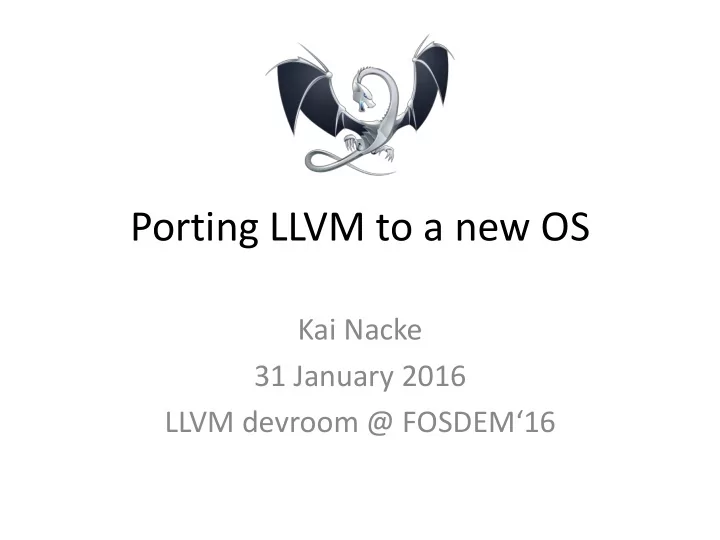

Porting LLVM to a new OS Kai Nacke 31 January 2016 LLVM devroom @ FOSDEM‘16
Porting LLVM • There are two possible goals – Run LLVM tools on OS – Generate code for OS / CPU architecture • Mission is to run LLVM on previously unsupported OS and adding code generation for the OS • Adding a new CPU architecture is a major task – Not considered here 31 January 2016 Kai Nacke | Porting LLVM to a new OS 2
A very brief look on AIX • OS for mission critial tasks • A UNIX OS, supports System V and BSD APIs • Runs on POWER architecture – Already a target for LLVM • Good software support – Native toolchain – Major Open Source Software available 31 January 2016 Kai Nacke | Porting LLVM to a new OS 3
Toolchain • Prerequisites for LLVM are available – gcc, cmake, gmake , … – Use this toolchain • GNU tools use as and ld from OS – Expect different command line options • Not every package works out of the box – Python 2.7.x is missing => compile yourself – cmake 3.x had problems => use cmake 2.8.x 31 January 2016 Kai Nacke | Porting LLVM to a new OS 4
Compile LLVM • First compiler run identifies code problems – Missing endian definitions – Wrong path handling code choosen • Linking fails because of unsupported options – Updates to the cmake modules necessary • Still problems with ThreadPool code – Needs more investigation 31 January 2016 Kai Nacke | Porting LLVM to a new OS 5
Running LLVM on AIX • All LLVM tools are compiled and run • Results of test suite are similar to Linux/PPC • Still no code generation for AIX 31 January 2016 Kai Nacke | Porting LLVM to a new OS 6
Code Generation • LLVM misses code generation for AIX • You can‘t use the Linux/PPC ELF-based tools – Binary format is XCOFF – Textual assembler is different • Idea is to tweak assembler generation and use external assembler to create object file 31 January 2016 Kai Nacke | Porting LLVM to a new OS 7
XCOFF • XCOFF is an extended COFF format • Basically it adds the TOC concept to COFF • Major differences to COFF – No PE header – Smallest adressable unit is csect – A csect always has a storage class associated • Assembler text uses .csect 31 January 2016 Kai Nacke | Porting LLVM to a new OS 8
Partial Class Hierarchy … changed <<uses>> AsmPrinter MCAsmInfo UsesAIXSectionDirective <<uses>> <<uses>> usesAIXSectionDirective() MCSection PPCAsmPrinter MCAsmInfoCOFF changed new MCSectionCOFF new PPCAIXAsmPrinter MCAsmInfoXCOFF <<instantiates>> changed new MCObjectFileInfo PPCAsmInfoXCOFF <<uses>> changed Triple 31 January 2016 Kai Nacke | Porting LLVM to a new OS 9
Implementation • Outputs .section as .csect – Required lot of changes • Makes storage class part of section name – Only a hack • Use raw text output for missing op‘s • Relocation syntax requires more work 31 January 2016 Kai Nacke | Porting LLVM to a new OS 10
Summary / Outlook • First patches submitted • Work on relocation syntax required – Needed for „ Hello World“ application • Working approach • Next step is dumping of XCOFF files 31 January 2016 Kai Nacke | Porting LLVM to a new OS 11
Recommend
More recommend